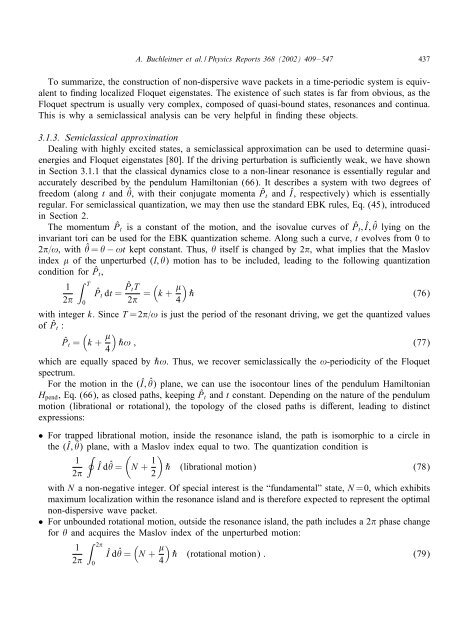Non-dispersive wave packets in periodically driven quantum systems
Non-dispersive wave packets in periodically driven quantum systems
Non-dispersive wave packets in periodically driven quantum systems
You also want an ePaper? Increase the reach of your titles
YUMPU automatically turns print PDFs into web optimized ePapers that Google loves.
A. Buchleitner et al. / Physics Reports 368 (2002) 409–547 437<br />
To summarize, the construction of non-<strong>dispersive</strong> <strong>wave</strong> <strong>packets</strong> <strong>in</strong> a time-periodic system is equivalent<br />
to nd<strong>in</strong>g localized Floquet eigenstates. The existence of such states is far from obvious, as the<br />
Floquet spectrum is usually very complex, composed of quasi-bound states, resonances and cont<strong>in</strong>ua.<br />
This is why a semiclassical analysis can be very helpful <strong>in</strong> nd<strong>in</strong>g these objects.<br />
3.1.3. Semiclassical approximation<br />
Deal<strong>in</strong>g with highly excited states, a semiclassical approximation can be used to determ<strong>in</strong>e quasienergies<br />
and Floquet eigenstates [80]. If the driv<strong>in</strong>g perturbation is su ciently weak, we have shown<br />
<strong>in</strong> Section 3.1.1 that the classical dynamics close to a non-l<strong>in</strong>ear resonance is essentially regular and<br />
accurately described by the pendulum Hamiltonian (66). It describes a system with two degrees of<br />
freedom (along t and ˆ , with their conjugate momenta ˆPt and Î, respectively) which is essentially<br />
regular. For semiclassical quantization, we may then use the standard EBK rules, Eq. (45), <strong>in</strong>troduced<br />
<strong>in</strong> Section 2.<br />
The momentum ˆPt is a constant of the motion, and the isovalue curves of ˆPt; Î; ˆ ly<strong>in</strong>g on the<br />
<strong>in</strong>variant tori can be used for the EBK quantization scheme. Along such a curve, t evolves from 0 to<br />
2 =!, with ˆ = − !t kept constant. Thus, itself is changed by 2 , what implies that the Maslov<br />
<strong>in</strong>dex of the unperturbed (I; ) motion has to be <strong>in</strong>cluded, lead<strong>in</strong>g to the follow<strong>in</strong>g quantization<br />
condition for ˆPt,<br />
1<br />
2<br />
T<br />
0<br />
ˆPt dt = ˆPtT<br />
2 =<br />
<br />
k +<br />
4<br />
˝ (76)<br />
with <strong>in</strong>teger k. S<strong>in</strong>ce T =2 =! is just the period of the resonant driv<strong>in</strong>g, we get the quantized values<br />
of ˆPt :<br />
<br />
ˆPt = k + ˝! ; (77)<br />
4<br />
which are equally spaced by ˝!. Thus, we recover semiclassically the !-periodicity of the Floquet<br />
spectrum.<br />
For the motion <strong>in</strong> the (Î; ˆ ) plane, we can use the isocontour l<strong>in</strong>es of the pendulum Hamiltonian<br />
Hpend, Eq. (66), as closed paths, keep<strong>in</strong>g ˆPt and t constant. Depend<strong>in</strong>g on the nature of the pendulum<br />
motion (librational or rotational), the topology of the closed paths is di erent, lead<strong>in</strong>g to dist<strong>in</strong>ct<br />
expressions:<br />
• For trapped librational motion, <strong>in</strong>side the resonance island, the path is isomorphic to a circle <strong>in</strong><br />
the (Î; ˆ ) plane, with a Maslov <strong>in</strong>dex equal to two. The quantization condition is<br />
<br />
1<br />
Î d<br />
2<br />
ˆ <br />
= N + 1<br />
<br />
˝ (librational motion)<br />
2<br />
(78)<br />
with N a non-negative <strong>in</strong>teger. Of special <strong>in</strong>terest is the “fundamental” state, N =0, which exhibits<br />
maximum localization with<strong>in</strong> the resonance island and is therefore expected to represent the optimal<br />
non-<strong>dispersive</strong> <strong>wave</strong> packet.<br />
• For unbounded rotational motion, outside the resonance island, the path <strong>in</strong>cludes a 2 phase change<br />
for and acquires the Maslov <strong>in</strong>dex of the unperturbed motion:<br />
2 1<br />
Î d<br />
2<br />
ˆ <br />
= N + ˝ (rotational motion) :<br />
4<br />
(79)<br />
0











